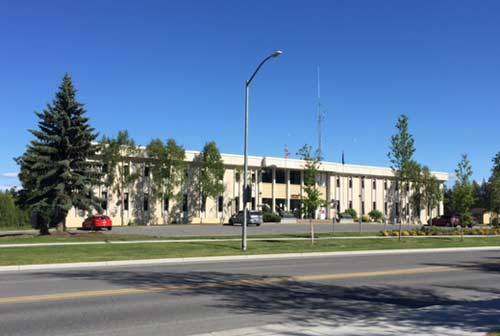With one meeting left before they have to approve the fiscal year 2019 budget, the members of the Kenai Peninsula Borough Assembly have yet to agree on a unified fix to the deficit.
Before approving a final budget for the coming year, the assembly has to address how to pay for an estimated $4 million shortfall between revenues and expenditures. While they have the option to draw out of the borough’s fund balance to make up the difference, drawing out of savings would push the fund balance close to the assembly’s minimum required level.
Members have proposed several options, but the assembly hasn’t agreed on one best approach. Borough Mayor Charlie Pierce proposed drawing about $4.5 million out of the borough’s land trust fund this year to make up the difference and increase the contribution to the Kenai Peninsula Borough School District, repaying the amount in fiscal years 2020 and 2021, but the assembly shot the option down.
Assembly member Paul Fischer asked for reconsideration of the land trust fund option at the Tuesday meeting, but the vote failed 5-4. He said the option merited more discussion than was had at the May 1 meeting.
“You’ve got lots of time put into this thing and very, very skimpy (discussion) to make a decision,” he said. “I think we should go back and look at it again.”
Assembly member Kelly Cooper proposed a sales tax increase, subject to voter approval, which would increase the borough’s general sales tax rate from 3 percent to 3.5 percent. However, to avoid the shortfall resulting from passing a budget in June and hoping that a tax proposition supporting it will pass in October, Cooper proposed an amendment to raise the mill rate by .6 mills. If the sales tax passes, it would sunset on Dec. 31 of any future year if the assembly chooses to raise the mill rate above 4.5 mills, the current rate.
The point is to encourage the assembly to lower the mill rate again if the sales tax increase passes, and to help keep the borough solvent if it doesn’t, Cooper said.
“What this ordinance does is it raises approximately $5.2 million, preserves fund balance, (and) will give voters the opportunity to select a revenue solution on the ballot,” she said.
However, the assembly voted the amendment down in a 4-5 split. The sales tax proposal was postponed to June 5, when the assembly will set the mill rate for the coming year and finalize the budget.
Assembly member Dale Bagley has propose two other options to raise revenue as well — a bed tax and a repeal of the seasonal nonprepared foods tax exemption. The nonprepared food tax exemption, known as the grocery tax, exempts some grocery items from sales tax from September 1 through May 31 each year. Since the assembly implemented it in 2009, sales tax revenues have fallen by about $3 million–$3.5 million annually. Repealing it would almost entirely meet the borough’s revenue needs, Bagley wrote in his memo.
The other option is a reworked bed tax, similar to efforts last year and earlier this year. The new verison, proposed by Bagley, would implement a 12 percent tax on temporary lodging like hotel rooms and bed and breakfasts, but would exempt them from general borough sales tax. That was one of the major complaints from lodge owners in prior discussions about a bed tax — because sales tax is calculated per night per head, they do not hit the cap on taxable sales and thus pay sales tax similar to a bed tax already.
Bagley wrote in his memo that the bed tax proposal would go to voters in October and, if passed, go into effect Jan. 1.
“Several hundred thousand visitors travel to the Kenai Peninsula each year and while they contribute to the area’s economy, they also create a large demand on public services in the borough,” he wrote.
The bed tax drew less public ire at the assembly meeting Tuesday night than it did in the past. Pierce mentioned there might be more public support this time for a tax that more clearly targets visitors than peninsula residents.
“We’ve spent a lot of time trying to figure out how to tax ourselves, the borough residents,” he said. “We’ve got every creative idea on ways to raise taxes on ourselves. And I think what we perhaps need to do is work on finding ways to maybe tax the 500,000 to 1 million tourists who come to our community and recreate and fish and camp and take advantage of the quality of life we have here on the peninsula.”
Most of the attendees at the meeting Tuesday asked for continued financial support for Kenai Peninsula College, which the borough contributes to each year. Others asked for the assembly to restore funding to the Kenai Peninsula Tourism Marketing Council, which Pierce’s proposed budget cut the support for by two-thirds.
Assembly member Hal Smalley proposed an amendment to increased the funding for the marketing organization from $100,000 to $306,000, the same amount it received this year. The amendment passed 5-4.
“The borough’s investment in tourism and marketing is not a donation to a nonprofit,” he said. “The investment is a contract with a marketing agency providing marketing for the Kenai Peninsula Borough. Now is not a time economically to see a big change there. This investment drives business and sales tax dollars.”
Bagley also cut several line items in the budget, reducing travel and subsistence funding for the assembly and the mayor, and cutting a proposed position for communications in the borough IT department. Chief of Staff John Quick said the idea for the position was to better reach out to people on social media and the web.
The assembly will amend and approve the final budget at the June 5 meeting.
Reach Elizabeth Earl at eearl@peninsulaclarion.com.

